Overview
To successfully sell wine online, one must grasp the legal requirements, select quality suppliers, and develop a robust branding and marketing strategy. Furthermore, building an effective eCommerce platform and implementing customer engagement strategies are crucial. This article delineates critical steps in each of these areas, underscoring the necessity of:
- Compliance with regulations
- The establishment of a distinctive brand identity
- The cultivation of customer relationships to bolster loyalty and drive sales
Introduction
Navigating the world of online wine sales presents both excitement and challenges, particularly given the complex legal landscape and competitive market. For aspiring vintners and established wineries, grasping the essential steps to successfully sell wine online is not just beneficial—it's imperative.
What strategies can be employed to ensure compliance with regulations while simultaneously captivating customers and fostering loyalty in a crowded digital marketplace?
This guide explores the fundamental aspects of selling wine online, offering insights that can transform a passion for winemaking into a thriving eCommerce venture.
Understand Legal Requirements for Selling Wine Online
Before embarking on selling your wine online, it is crucial to grasp the legal framework governing alcohol transactions. This understanding includes obtaining the requisite licenses, which can vary significantly from state to state. To navigate this landscape effectively, follow these essential steps:
- Research State Laws: Each state enforces unique regulations concerning the sale and shipment of alcohol. Leverage resources such as the Wine Institute or state liquor control boards to gain insights into specific requirements. For example, some states are classified as 'control states,' where the government oversees alcohol sales, while others are 'open states,' permitting private businesses to secure licenses.
- Obtain Necessary Licenses: Secure a federal Basic Permit from the Alcohol and Tobacco Tax and Trade Bureau (TTB), in addition to any state-specific licenses. This often entails acquiring a direct-to-consumer (DTC) shipping license, which is vital for selling your wine online.
- Understand Shipping Regulations: Familiarize yourself with , including age verification requirements and restrictions on the quantity of alcohol shipped. Certain states impose limits on how much a consumer can receive, and robust age verification processes are mandatory at both purchase and delivery stages.
- Stay Updated: Regulations are subject to change, making it essential to regularly check for updates to ensure ongoing compliance. Local ordinances may also impose additional rules, complicating the licensing process.
By diligently fulfilling all legal obligations, wine producers can sidestep costly pitfalls and concentrate on selling your wine online, as well as enhancing their visibility and customer engagement.
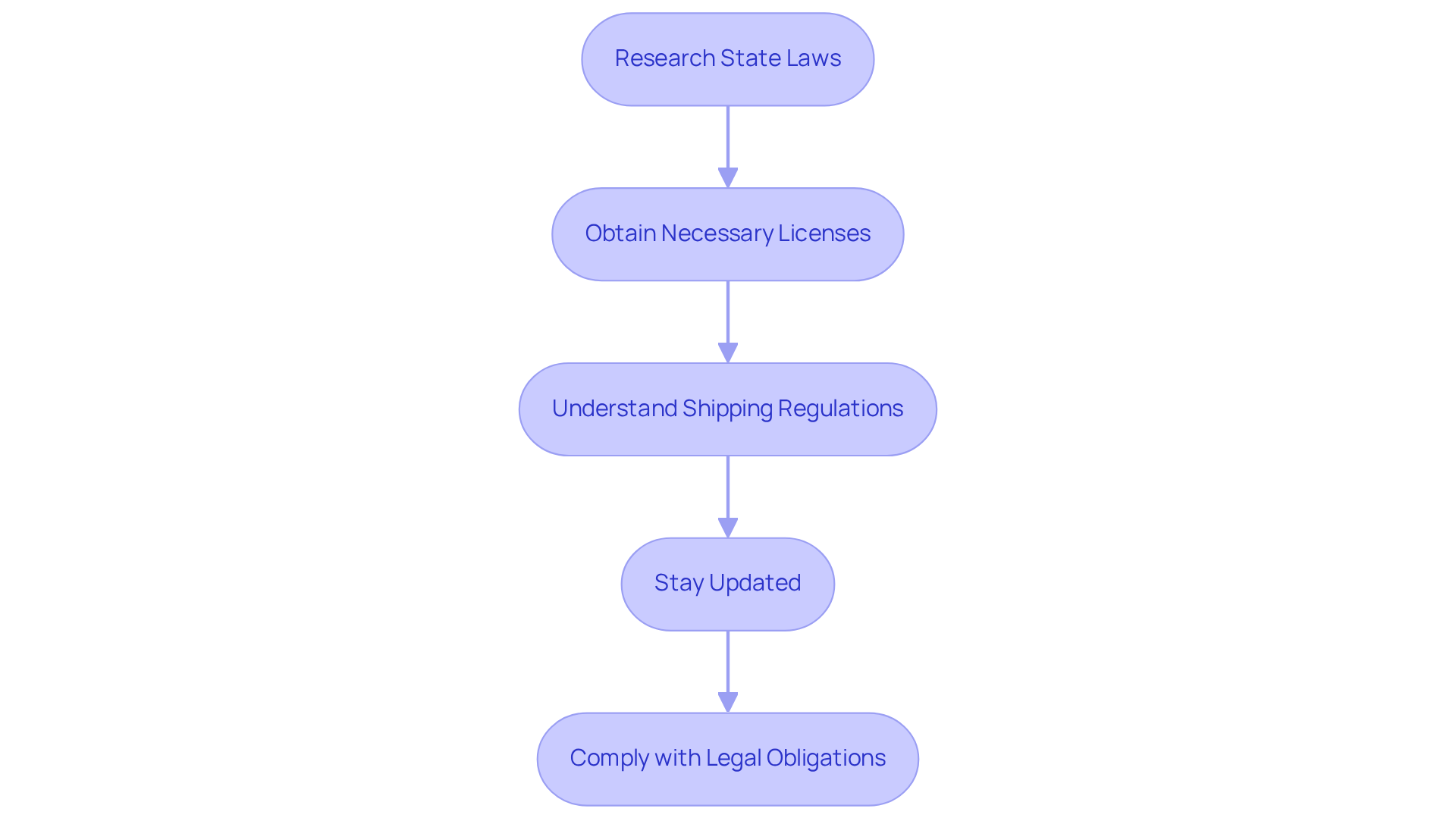
Choose Your Wine Selection and Suppliers
Choosing the right beverages and suppliers is critical for a successful strategy when selling your wine online, especially for family-owned vineyards striving to thrive in a competitive marketplace. Here are essential steps to guide you:
- Define Your Niche: Clearly identify the specific types of wines you intend to sell, such as organic, local, or premium selections. This focus streamlines your marketing efforts and resonates with your target audience, .
- Research Suppliers: Seek reputable suppliers recognized for their quality and reliability. Assess aspects such as their portfolio, reputation, service quality, pricing, delivery performance, and product variety to ensure alignment with your business requirements. Consider how these suppliers can bolster your direct-to-consumer strategies and how Enocap's capital advisory services can aid in selecting financially stable partners.
- Sample Products: Before finalizing any agreements, request samples from potential suppliers. This step allows you to evaluate the quality of their products, ensuring that your selections meet the high standards expected by your clients.
- Negotiate Terms: Engage in discussions regarding pricing, minimum order quantities, and shipping conditions. Establishing clear and favorable terms can lead to a mutually beneficial partnership that supports your business goals and aligns with strategic capital planning.
- Build Relationships: Cultivating strong relationships with your suppliers can lead to enhanced service and potential exclusivity on certain products. Open communication and regular check-ins foster trust and collaboration, which are vital for long-term success.
- Assess Financial Stability: Evaluate the financial stability of your suppliers to ensure timely payments and reliability in your supply chain. This assessment is crucial for maintaining a smooth operational flow and securing the right capital for growth opportunities.
- Emphasize Quality Assurance: Ensure that your suppliers have stringent quality control measures in place, including certifications and regular quality checks, to maintain the integrity of your beverage offerings.
- Consider Sustainability and Ethical Sourcing: With the growing consumer demand for responsible practices, selecting suppliers who engage in sustainable and ethical sourcing can enhance your brand's reputation and appeal to conscientious consumers.
- Monitor Supplier Performance: Regularly evaluate your suppliers' performance to ensure they continue to meet your standards and adapt to changing market conditions.
By meticulously selecting your wine offerings and opting for dependable suppliers, you can create an attractive product range for selling your wine online that not only draws in customers but also fosters loyalty in a competitive marketplace, ultimately promoting sustainable growth for your family-owned business.
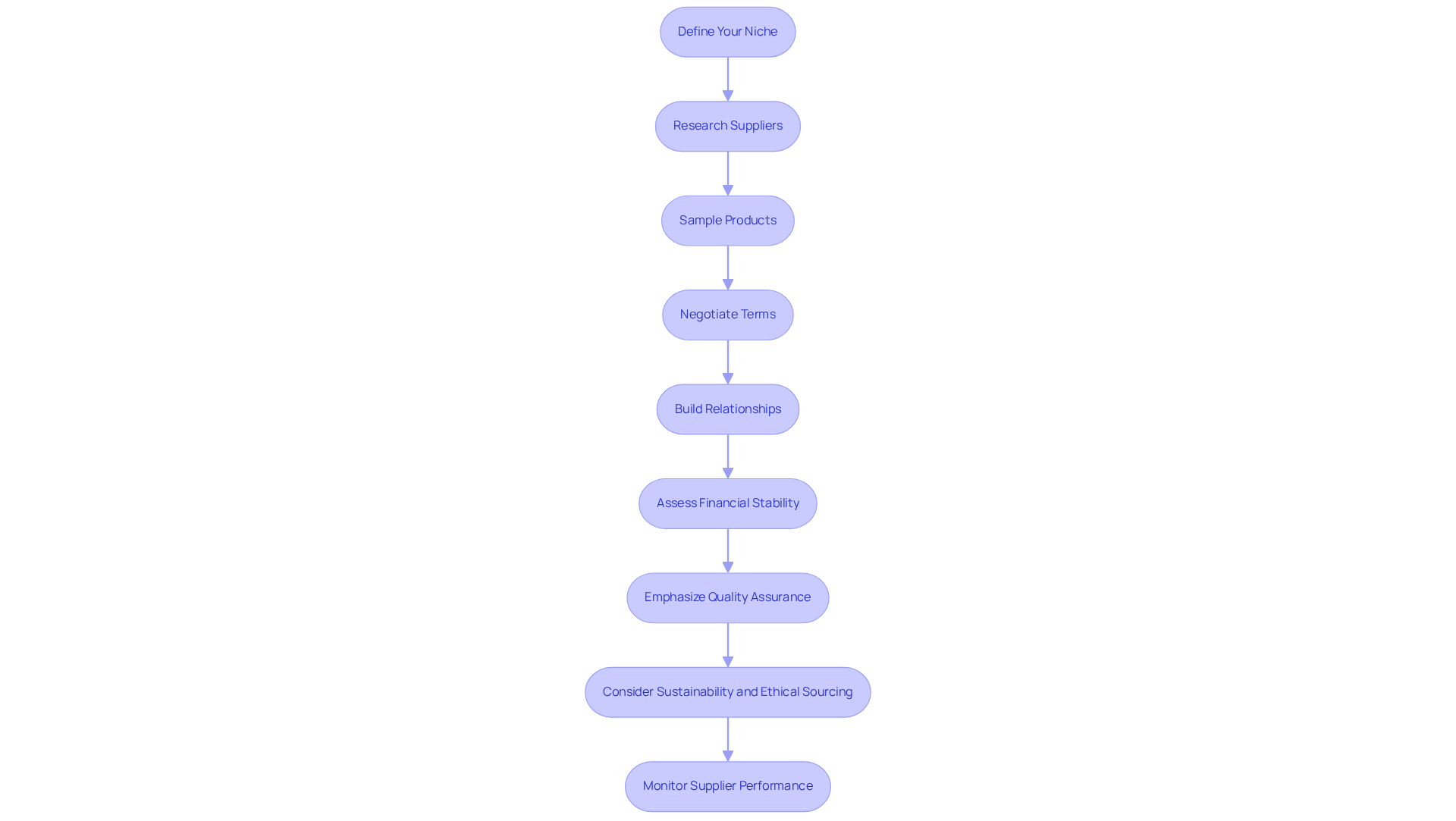
Develop Your Branding and Marketing Strategy
Developing a compelling branding and marketing strategy is essential for your online success. Here’s how to achieve it:
- Define Your Brand Identity: Identify what sets your establishment apart. This may include your heritage, winemaking process, or commitment to sustainability, all of which resonate with today’s environmentally conscious consumers.
- Create a Brand Story: Craft a narrative that emotionally connects with your audience. Share your winery's history, values, and the passion behind your wines. Genuine storytelling is crucial; research shows that 71% of clients are more inclined to purchase based on social media recommendations, and 87% of purchasers believe social media aids their shopping decisions. This storytelling can also transform casual buyers into loyal club members, a proven strategy for enhancing client retention.
- Design Visual Elements: Develop a logo, color scheme, and packaging that reflect your brand identity. Consistency in visual elements fosters recognition and trust among consumers, ensuring your winery stands out in a crowded market.
- Utilize Digital Marketing: Leverage social media, , and content marketing to reach your audience effectively. Share engaging content, including wine pairing tips, behind-the-scenes insights, and client testimonials. Email marketing remains effective, with open rates around 20.2% for wine-related campaigns, making it an essential tool for nurturing relationships with both current and prospective clients.
- Engage with Your Audience: Cultivate a community around your brand by interacting with clients on social media and through newsletters. Encourage feedback and establish loyalty programs to retain clients. Additionally, consider experiential marketing approaches, such as hosting vineyard tours and tastings, to create memorable interactions that deepen consumer relationships. These strategies not only enhance client loyalty but also promote sustainable growth by establishing direct-to-consumer channels that generate consistent revenue.
By creating a robust brand and marketing strategy, you can effectively attract and retain customers in the online beverage market through selling your wine online, ensuring your winery thrives for generations.
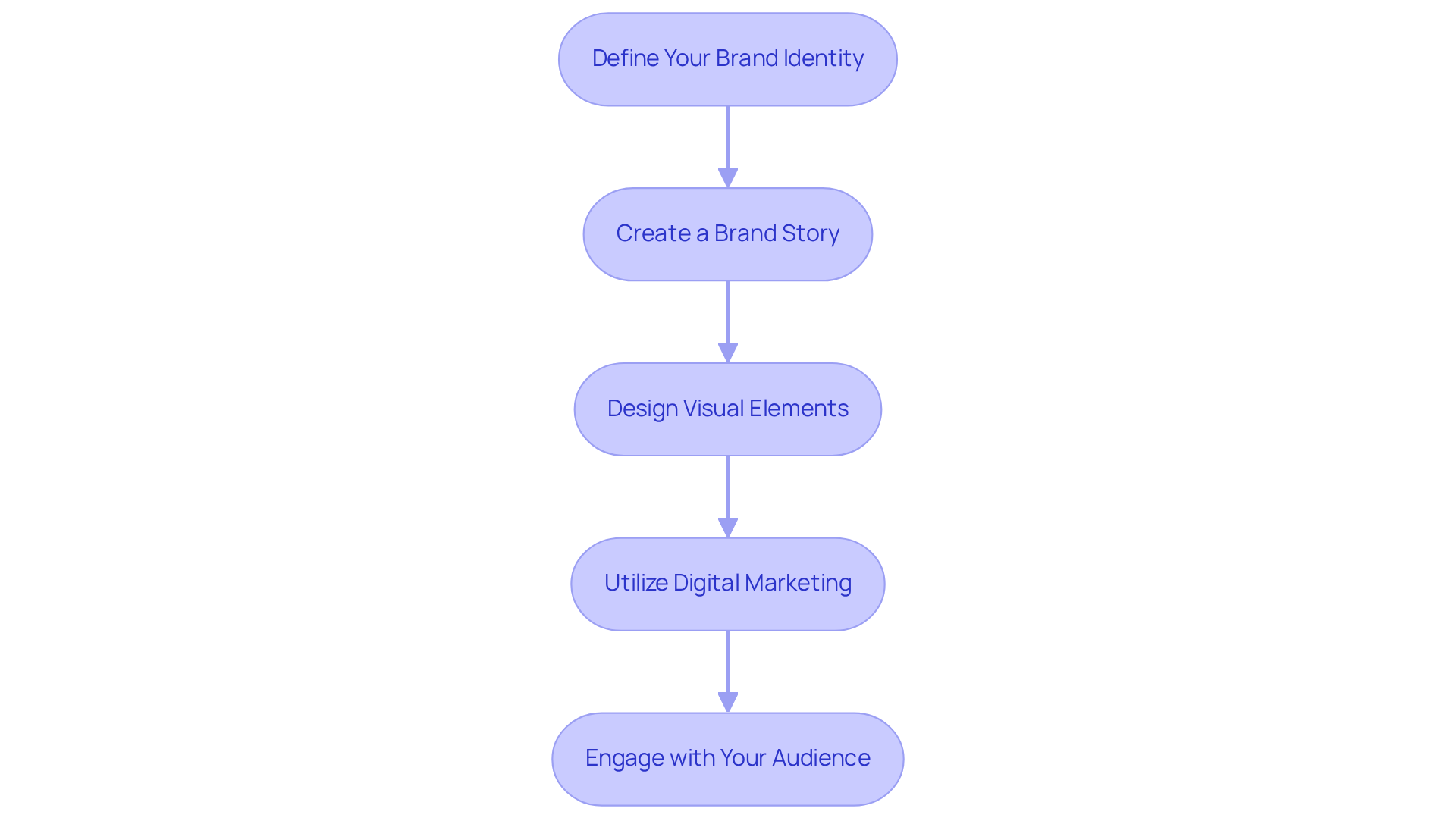
Build Your eCommerce Platform for Wine Sales
Establishing a robust eCommerce platform is essential for selling your wine online and tapping into direct-to-consumer revenue in the online beverage market. To achieve this, consider the following steps:
- Choose the Right Platform: Select an eCommerce platform tailored specifically for the wine industry, such as Commerce7 or WineDirect. Prioritize features like , age verification, and shipping integrations to ensure compliance with legal regulations.
- Design Your Storefront: Create an appealing and user-friendly website. It must be mobile-responsive and easy to navigate, featuring clear product categories and effective search functionality. Personalization enhances the shopping experience by leveraging data for tailored product recommendations and custom marketing campaigns. Crafting an engaging brand narrative can transform casual buyers into loyal club members, fostering a deeper connection with your clientele.
- Set Up Payment Processing: Integrate secure payment gateways to streamline transactions. Ensure compliance with PCI standards and local and international alcohol distribution regulations to protect consumer information and build trust.
- Implement Shipping Solutions: Partner with reliable shipping providers and establish logistics for wine delivery. Clearly communicate shipping policies and costs to clients, ensuring transparency and reliability.
- Optimize for SEO: Employ search engine optimization techniques to enhance your website’s visibility. Concentrate on relevant keywords, meta descriptions, and high-quality content to attract organic traffic. Additionally, utilize data analysis to monitor performance metrics such as traffic and conversion rates, facilitating ongoing optimization of your eCommerce strategies.
- Integrate CRM Systems: Consider integrating client relationship management (CRM) systems with your eCommerce platform. This integration is vital for enhancing client engagement and understanding purchasing behavior, essential for cultivating long-term relationships with your clients. Strategic capital planning can bolster these efforts by identifying growth and investment opportunities.
By developing a well-structured eCommerce platform and implementing these strategies for selling your wine online, you can significantly enhance the shopping experience and effectively increase sales, ensuring the longevity and success of your family winery.
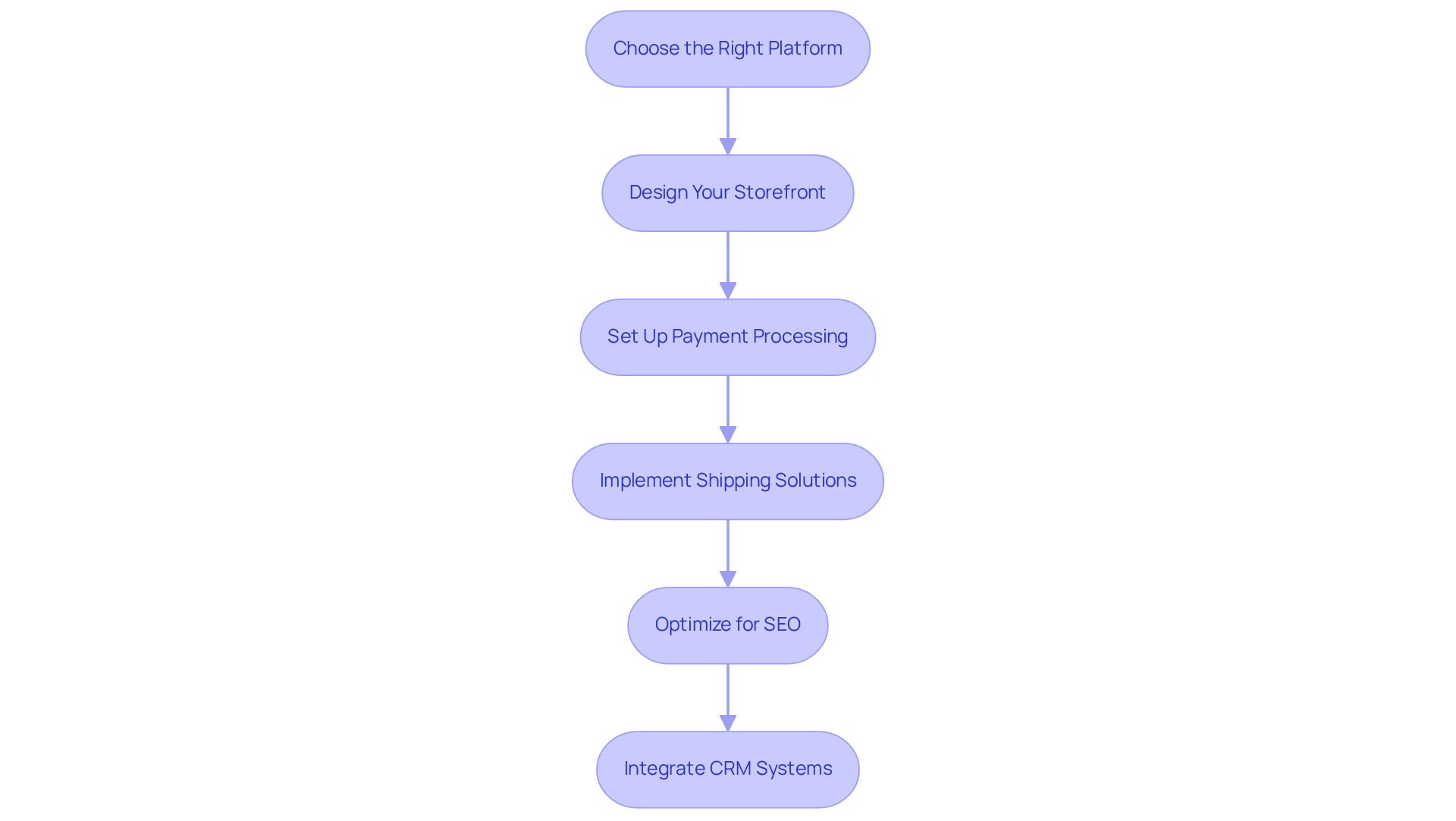
Implement Customer Engagement and Retention Strategies
To ensure long-term success in selling your wine online, it is crucial to implement effective . Here’s how to achieve this with transformative approaches from Enocap:
- Personalize Communication: Utilize client data to customize your communications. Sending personalized emails with suggestions based on previous purchases or preferences can significantly improve client satisfaction and loyalty. This aligns with Enocap's focus on crafting compelling brand narratives that resonate with consumers.
- Create Loyalty Programs: Develop a rewards program that incentivizes repeat purchases. Effective loyalty programs provide discounts, exclusive access to new releases, or invitations to special events, fostering a sense of belonging among patrons. For example, establishments that adopt tiered membership models can improve client interaction and decrease churn. Enocap's capital advisory services can support the development and execution of these programs, ensuring they are sustainable and effective.
- Engage on Social Media: Utilize social media platforms to interact with your audience. Sharing user-generated content, responding to comments, and creating polls or contests can foster a vibrant community around your brand, driving both engagement and loyalty. Enocap emphasizes the importance of storytelling in building these connections, making social media a powerful tool for family-owned wineries.
- Solicit Feedback: Regularly seek client feedback through surveys or reviews. This information is invaluable for enhancing your offerings and addressing any concerns, ultimately leading to higher client retention rates. Monitoring attendance figures and participant feedback from events can also assess the effectiveness of your engagement approaches, emphasizing the necessity for strategic capital planning to support these initiatives.
- Host Events: Organize virtual tastings, webinars, or in-person gatherings to deepen connections with clients. These experiences not only enhance brand loyalty but also create memorable interactions that encourage repeat business. High turnout and favorable feedback signify the effectiveness of experiential marketing approaches, enabling vineyards to enhance upcoming events. Enocap's expertise in securing the right capital can assist vineyards in investing in these valuable client engagement opportunities.
By prioritizing customer engagement and retention, and leveraging Enocap's transformative DTC strategies, wineries can cultivate a loyal customer base that significantly supports selling your wine online.
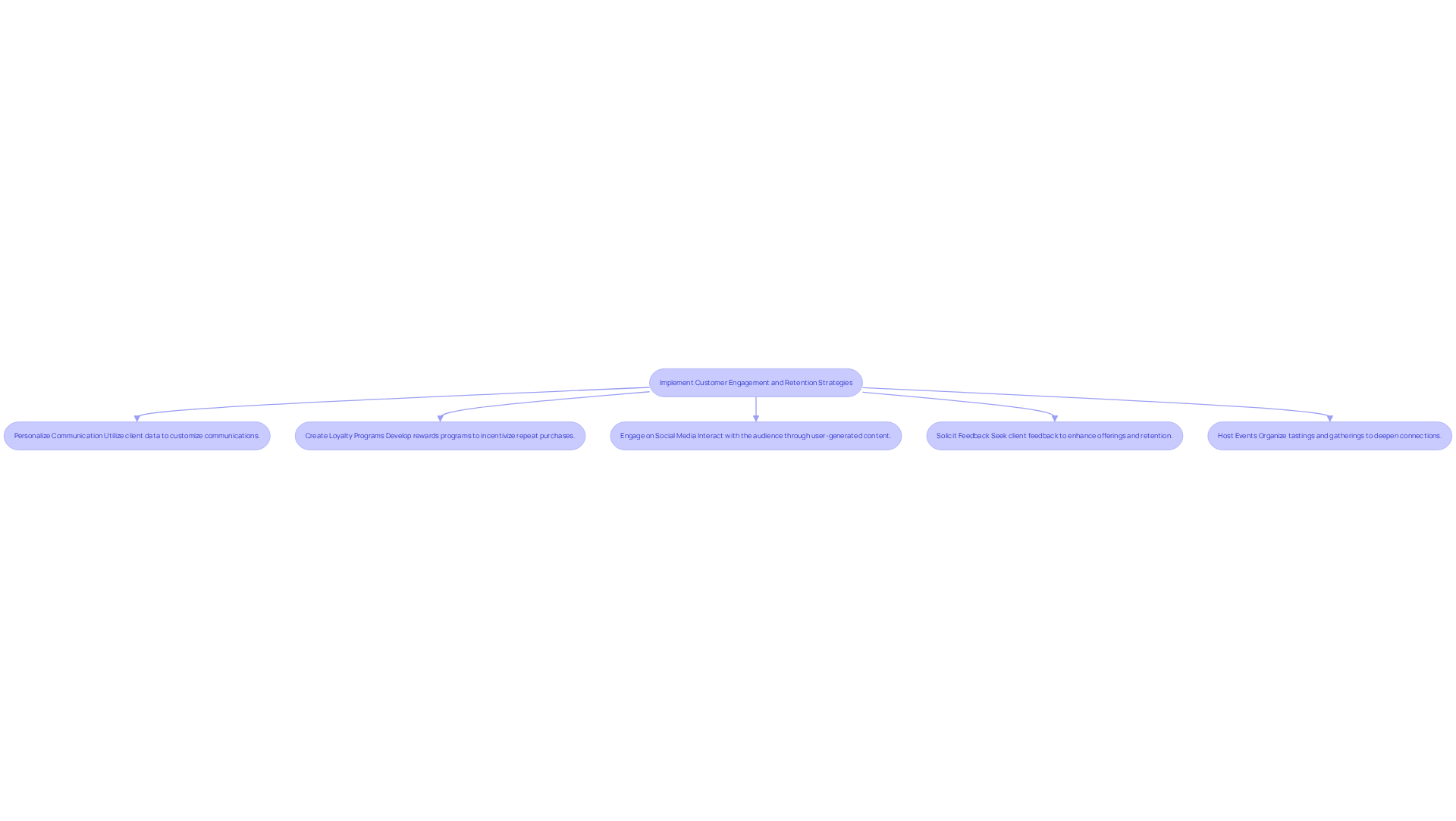
Conclusion
Selling wine online offers wineries a unique opportunity to expand their reach and navigate the complex landscape of legal requirements and market dynamics. By grasping the essential steps outlined in this guide, wine producers can position themselves effectively for success in the digital marketplace.
Key elements discussed underscore the importance of adhering to legal regulations, selecting the right wines and suppliers, and crafting a strong branding and marketing strategy. A robust eCommerce platform is vital for facilitating sales, while effective customer engagement and retention strategies cultivate long-term loyalty and repeat business. Each step is interconnected, forming a comprehensive approach that can elevate a winery's online presence and profitability.
Ultimately, the journey of selling wine online transcends mere transactions; it’s about forging lasting relationships with customers and building a brand that resonates with their values. By embracing these strategies, wineries not only enhance visibility and sales but also foster a community of loyal patrons eager to support family-owned businesses. By taking informed actions today, wineries can thrive in the competitive online landscape, ensuring their legacy endures for generations to come.
Frequently Asked Questions
What are the legal requirements for selling wine online?
To sell wine online, it is essential to understand the legal framework, which includes obtaining necessary licenses that vary by state. This involves researching state laws, securing a federal Basic Permit from the TTB, and obtaining any state-specific licenses, such as a direct-to-consumer shipping license.
How can I research state laws regarding wine sales?
You can research state laws by leveraging resources like the Wine Institute or state liquor control boards, which provide insights into specific regulations concerning the sale and shipment of alcohol.
What are the shipping regulations I need to be aware of when selling wine online?
Shipping regulations include age verification requirements and restrictions on the quantity of alcohol shipped. Some states limit how much a consumer can receive, and robust age verification processes are mandatory during both purchase and delivery.
Why is it important to stay updated on regulations for selling wine online?
Regulations can change, so it is crucial to regularly check for updates to ensure ongoing compliance. Local ordinances may also impose additional rules that complicate the licensing process.
What steps should I take to choose the right wine selection and suppliers?
Start by defining your niche, researching reputable suppliers, sampling products, negotiating terms, building relationships, assessing financial stability, emphasizing quality assurance, considering sustainability, and monitoring supplier performance.
How can I define my niche when selling wine online?
Clearly identify the specific types of wines you intend to sell, such as organic, local, or premium selections, which will streamline your marketing efforts and resonate with your target audience.
What factors should I consider when researching suppliers?
Consider the supplier's portfolio, reputation, service quality, pricing, delivery performance, and product variety to ensure they align with your business requirements.
Why is it important to sample products from suppliers before finalizing agreements?
Sampling products allows you to evaluate the quality of their offerings, ensuring that your selections meet the high standards expected by your clients.
How can I build strong relationships with my suppliers?
Cultivating strong relationships involves open communication, regular check-ins, and fostering trust and collaboration, which are vital for long-term success.
What should I evaluate regarding the financial stability of my suppliers?
Assessing the financial stability of suppliers is crucial to ensure timely payments and reliability in your supply chain, which helps maintain smooth operational flow.
Why is quality assurance important when selecting suppliers?
Ensuring suppliers have stringent quality control measures in place is essential to maintain the integrity of your beverage offerings.
How does sustainability and ethical sourcing impact my wine business?
Selecting suppliers who engage in sustainable and ethical sourcing can enhance your brand's reputation and appeal to consumers who prioritize responsible practices.
How can I monitor supplier performance effectively?
Regularly evaluate your suppliers' performance to ensure they continue to meet your standards and can adapt to changing market conditions.




